 *Critters we’ve seen on our
2014 trip so far: pronghorn, horse, llama,
elk, bison, grizzly, bighorn sheep, mule deer, Uinta ground squirrel, wolf,
black bear, moose, coyote, fox, bullsnake, bat, white-tailed jackrabbit, mountain goat
*Critters we’ve seen on our
2014 trip so far: pronghorn, horse, llama,
elk, bison, grizzly, bighorn sheep, mule deer, Uinta ground squirrel, wolf,
black bear, moose, coyote, fox, bullsnake, bat, white-tailed jackrabbit, mountain goat
 *Birds we’ve seen on our 2014
trip so far: bald eagle, grouse, osprey, magpie, red-tailed hawk, Canada goose,
great horned owl, American kestrel, sandhill crane, mountain bluebird, cliff swallow, Ferruginous
hawk
*Birds we’ve seen on our 2014
trip so far: bald eagle, grouse, osprey, magpie, red-tailed hawk, Canada goose,
great horned owl, American kestrel, sandhill crane, mountain bluebird, cliff swallow, Ferruginous
hawk
[Click on any photo to enlarge.]
 Now some of you are probably going
to have a hard time believing what I’m about to tell you, but it’s true. For the first time in about 20 years Russ and
I went tent camping…yes, really…for 3
nights. Since it had been so long, we
set the tent up in our drive way the
Now some of you are probably going
to have a hard time believing what I’m about to tell you, but it’s true. For the first time in about 20 years Russ and
I went tent camping…yes, really…for 3
nights. Since it had been so long, we
set the tent up in our drive way the
 week before to make sure all of the pieces
were still there and filled the air mattress to check for leaks. Then we packed the car with plenty of
provisions, and of course, Abby, and headed for Glacier National Park
(www.nps.gov/glac).
week before to make sure all of the pieces
were still there and filled the air mattress to check for leaks. Then we packed the car with plenty of
provisions, and of course, Abby, and headed for Glacier National Park
(www.nps.gov/glac).
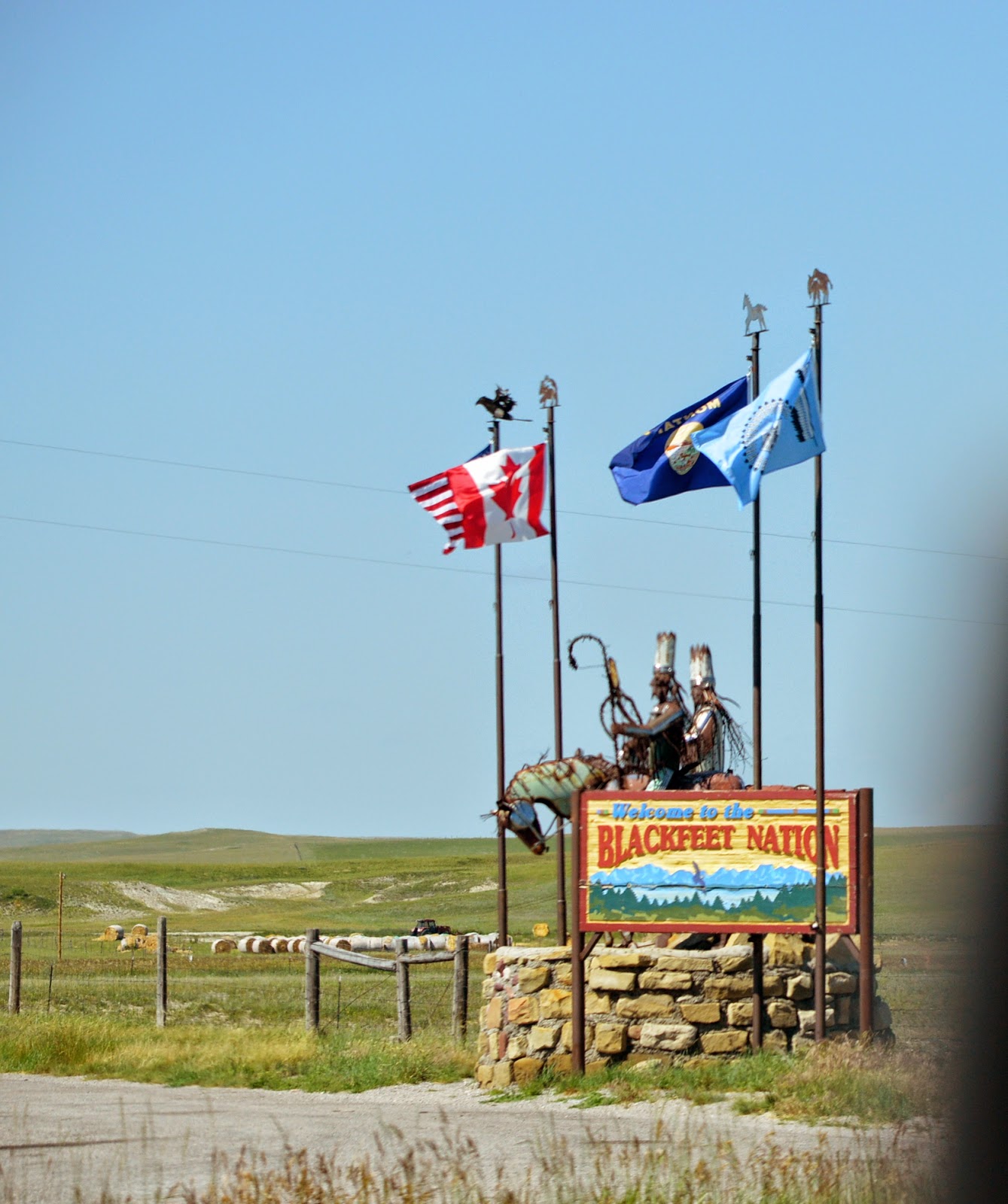 Our drive found us passing through
the Blackfeet Indian Reservation, and we even took a little back road that we
could not have taken with the RV when we visited the park 5 years ago. Though we stayed outside the park back then,
this time we made reservations at one
of only two campgrounds that take them, and it just so happened that the only 2
days available at either campground during the entire month of
Our drive found us passing through
the Blackfeet Indian Reservation, and we even took a little back road that we
could not have taken with the RV when we visited the park 5 years ago. Though we stayed outside the park back then,
this time we made reservations at one
of only two campgrounds that take them, and it just so happened that the only 2
days available at either campground during the entire month of
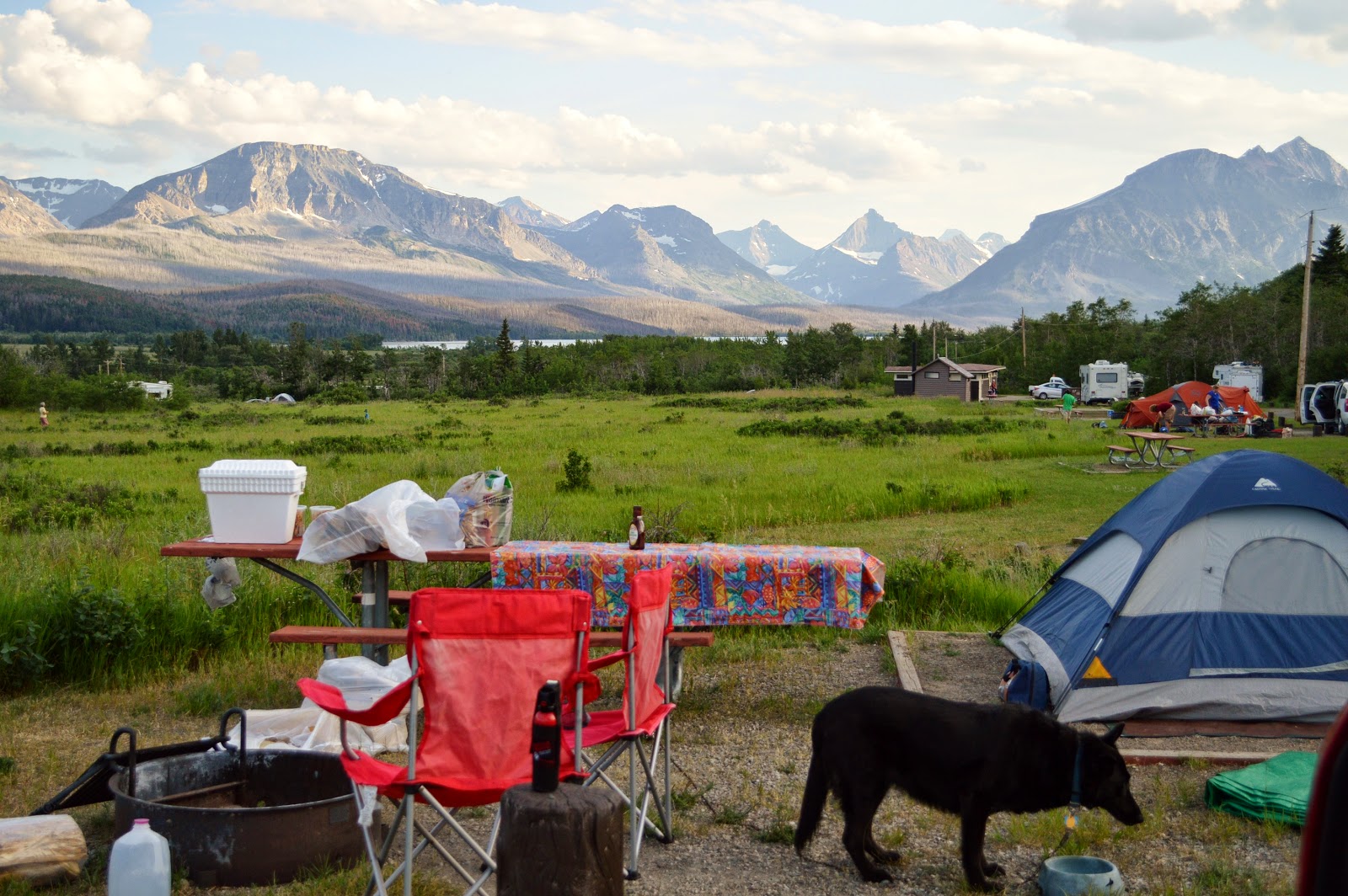 July were the
days we were looking to stay. Definitely
must have been a sign. (Depending on how
those 2 nights went would determine whether we’d stay longer. J) Though our campsite at St. Mary’s Campground
July were the
days we were looking to stay. Definitely
must have been a sign. (Depending on how
those 2 nights went would determine whether we’d stay longer. J) Though our campsite at St. Mary’s Campground
 offered
no shade (and it was fairly warm while we were there), we had a lovely view,
and since things cooled down in the evening, we were able to enjoy a campfire
each night.
offered
no shade (and it was fairly warm while we were there), we had a lovely view,
and since things cooled down in the evening, we were able to enjoy a campfire
each night.
 With such a long drive to get
there (about 400 miles), we didn’t do much that first night other than set up
camp and go to the St. Mary’s Visitor Center followed by a campfire. However the next morning, after a hearty
breakfast, we took off to drive the 50 mile Going-to-the-Sun Road. Our plan was to go only as far as the summit
at Logan’s Pass (elevation 6,646 ft.) which sits atop the Continental Divide,
but we ended up going about another 15 miles before turning around to head back
With such a long drive to get
there (about 400 miles), we didn’t do much that first night other than set up
camp and go to the St. Mary’s Visitor Center followed by a campfire. However the next morning, after a hearty
breakfast, we took off to drive the 50 mile Going-to-the-Sun Road. Our plan was to go only as far as the summit
at Logan’s Pass (elevation 6,646 ft.) which sits atop the Continental Divide,
but we ended up going about another 15 miles before turning around to head back
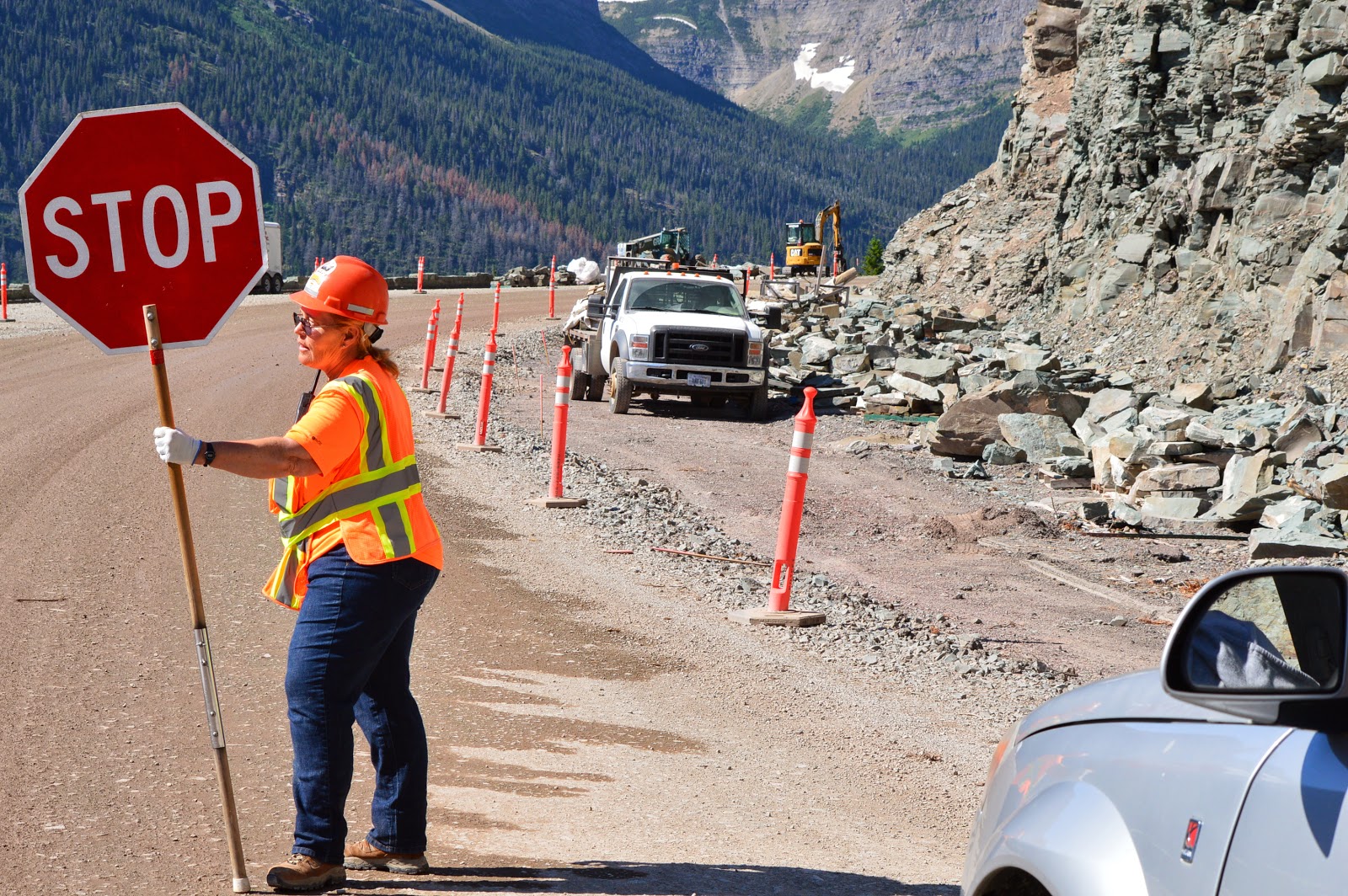 (not much to see past that point other than lots of evergreens). There’s road construction being done on the
road this summer, but the delays gave us the opportunity to stretch our legs
and enjoy the scenery like tiny Wild Goose Island
situated out
(not much to see past that point other than lots of evergreens). There’s road construction being done on the
road this summer, but the delays gave us the opportunity to stretch our legs
and enjoy the scenery like tiny Wild Goose Island
situated out
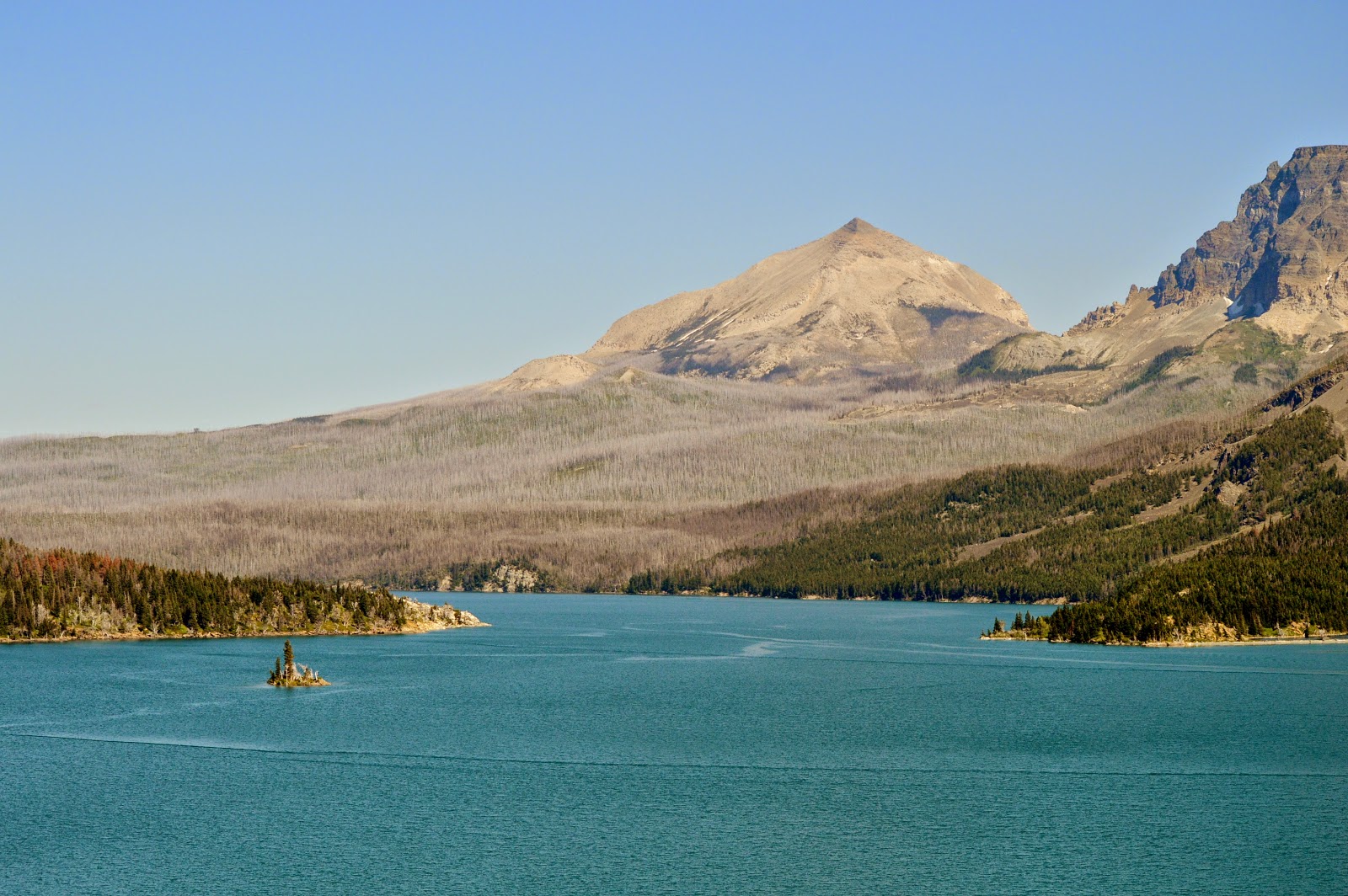 in the middle of St.
Mary Lake
with majestic peaks rising in the distance.
Continuing on our drive, the views along the way were still as
breathtakingly beautiful as I had remembered.
Russ said he had forgotten just how beautiful the park was so neither of
us was disappointed. There wasn’t as
in the middle of St.
Mary Lake
with majestic peaks rising in the distance.
Continuing on our drive, the views along the way were still as
breathtakingly beautiful as I had remembered.
Russ said he had forgotten just how beautiful the park was so neither of
us was disappointed. There wasn’t as
 much snow on the sides of the road as during our last visit, but the waterfalls cascading from everywhere were spectacular. (There was a definite haze in the air from some Canadian forest fires so some of the photos might not look as sharp.)
much snow on the sides of the road as during our last visit, but the waterfalls cascading from everywhere were spectacular. (There was a definite haze in the air from some Canadian forest fires so some of the photos might not look as sharp.)
 Snow was still quite evident at
the Logan Pass Visitor
Center despite the 80
degree temperatures, and kids were having a blast sliding down the
snowbank. From behind the center one can
catch the Hidden Lake Trail, a 3 mile roundtrip hike up the base of Clements Mountain, and if you look closely at the
photo below left, you can see plenty of folks making the trek (not us). There was plenty of other snow in the area for
us to walk on without a hike!
Snow was still quite evident at
the Logan Pass Visitor
Center despite the 80
degree temperatures, and kids were having a blast sliding down the
snowbank. From behind the center one can
catch the Hidden Lake Trail, a 3 mile roundtrip hike up the base of Clements Mountain, and if you look closely at the
photo below left, you can see plenty of folks making the trek (not us). There was plenty of other snow in the area for
us to walk on without a hike!
 One of the highlight attractions along
the Going-to-the-Sun Road
is the Weeping Wall (though while we were there it appeared to be more sobbing
than weeping!) This 100 ft. long geological
formation is fed from snowmelt in the mountains that makes its way down and
One of the highlight attractions along
the Going-to-the-Sun Road
is the Weeping Wall (though while we were there it appeared to be more sobbing
than weeping!) This 100 ft. long geological
formation is fed from snowmelt in the mountains that makes its way down and
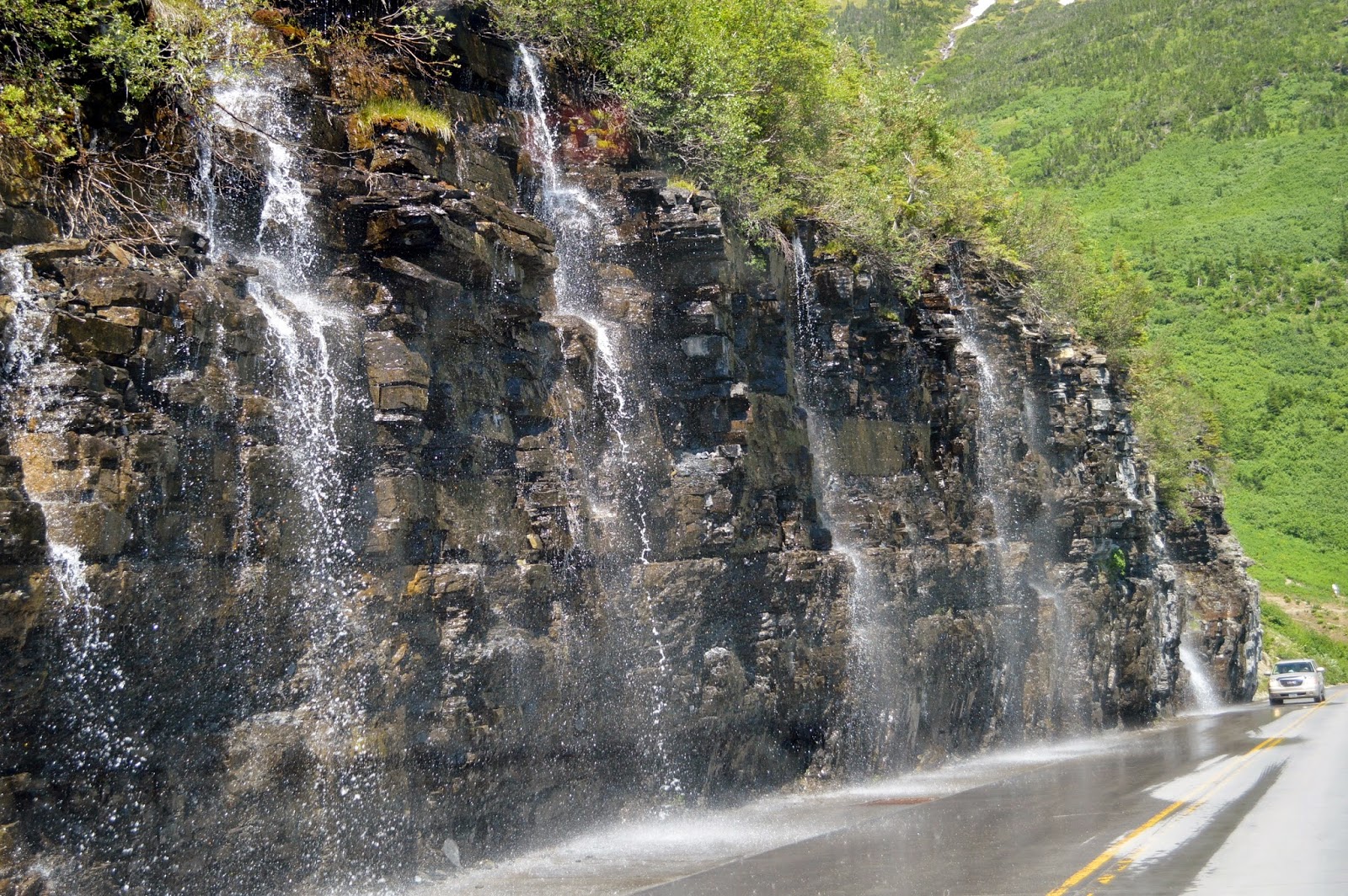 through the rock formations. During the
spring, it’s wise to roll up your windows as you pass by, but during the summer,
snowmelt slows to a trickle so chances of getting wet are rare.
through the rock formations. During the
spring, it’s wise to roll up your windows as you pass by, but during the summer,
snowmelt slows to a trickle so chances of getting wet are rare.
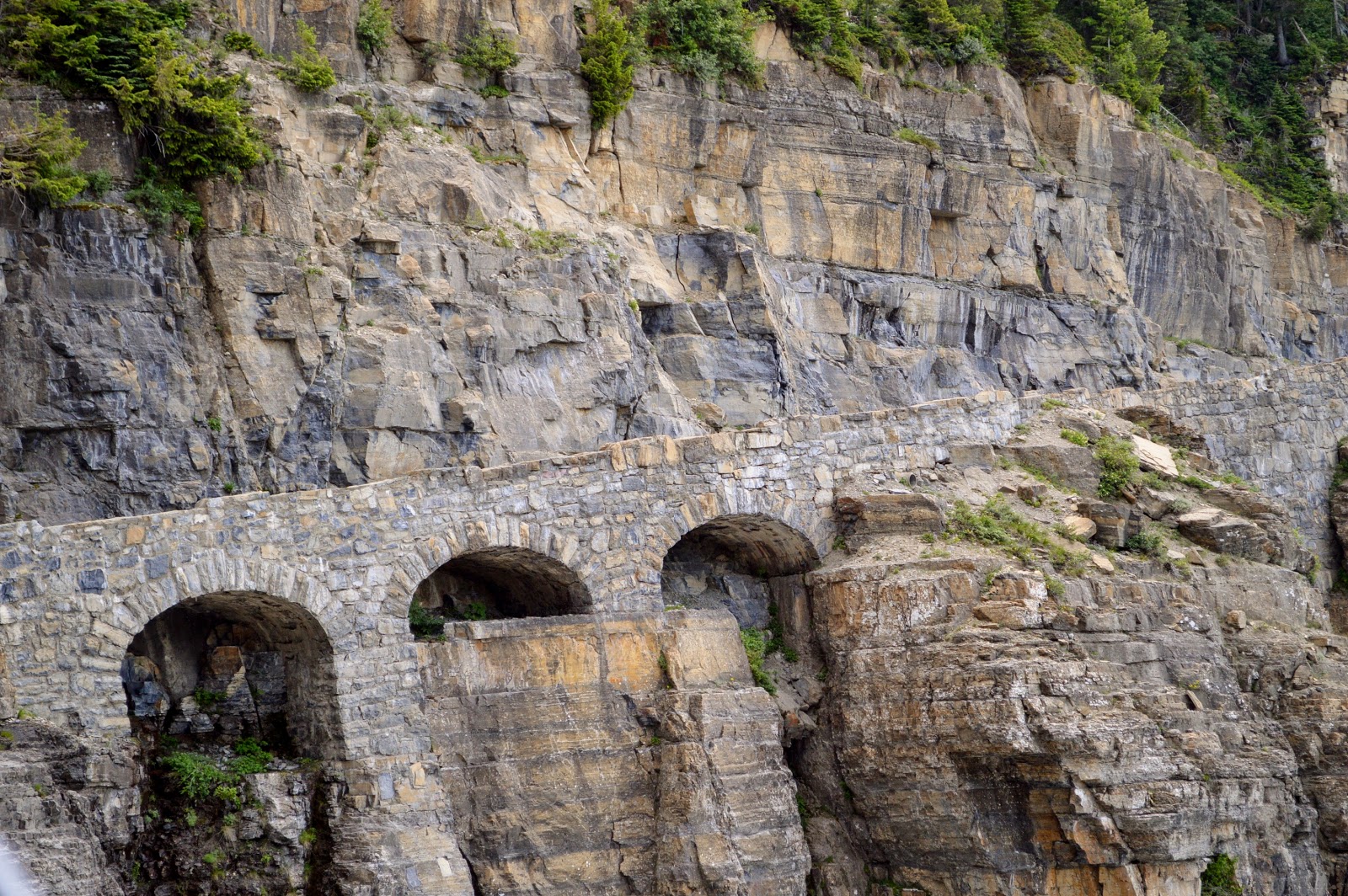 The road itself is an engineering
marvel that was completed in 1932 after nearly 30 years of planning and
construction. The Triple Arch Bridge,
built in the 1920s, spans 60 ft. across a gap in the mountain, and there are
two tunnels, one measuring approximately 408 ft. long and the other about 192
ft.
The road itself is an engineering
marvel that was completed in 1932 after nearly 30 years of planning and
construction. The Triple Arch Bridge,
built in the 1920s, spans 60 ft. across a gap in the mountain, and there are
two tunnels, one measuring approximately 408 ft. long and the other about 192
ft.
 Since we had all survived 2 nights
sleeping in the tent, we decided to see if we could get another night here
instead of moving to Many Glacier, a first-come first-serve campground some 20
miles away. We’d heard that we would probably need to be there by 8am to find a
spot. As it turned out, we got another
site at St. Mary’s and only had to move everything a few yards. After another hearty breakfast, it was off to
visit the Many Glacier area of the park, often referred to as “the heart of
Glacier”. Though this area doesn’t
Since we had all survived 2 nights
sleeping in the tent, we decided to see if we could get another night here
instead of moving to Many Glacier, a first-come first-serve campground some 20
miles away. We’d heard that we would probably need to be there by 8am to find a
spot. As it turned out, we got another
site at St. Mary’s and only had to move everything a few yards. After another hearty breakfast, it was off to
visit the Many Glacier area of the park, often referred to as “the heart of
Glacier”. Though this area doesn’t
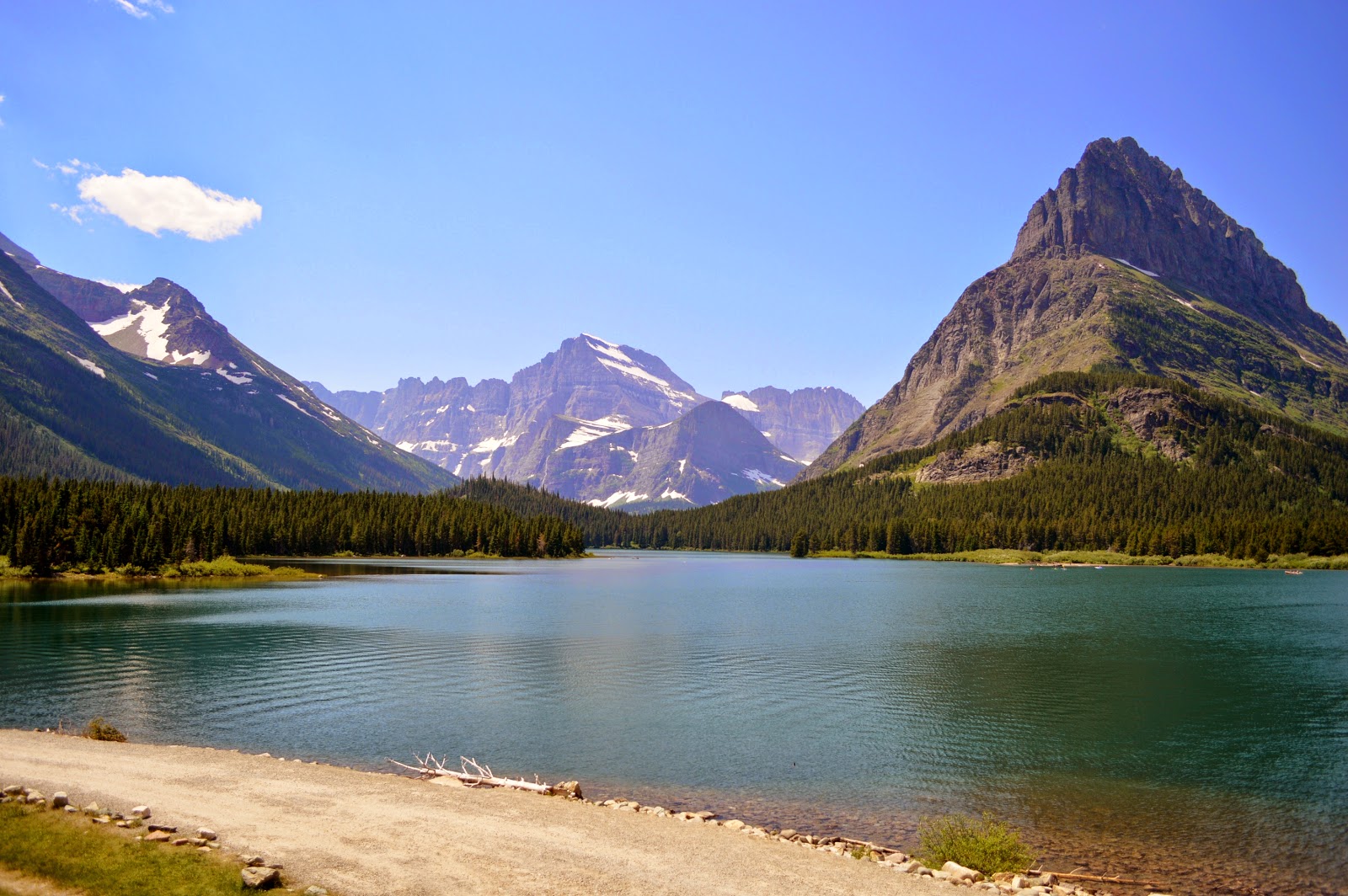 have
many easily seen waterfalls like along the Going-to-the-Sun Road, it’s still beautiful, and our main goal here was a
stop at the historic Swiss alpine themed Many Glacier Hotel located on the Swiftcurrent Lake.
The views from
have
many easily seen waterfalls like along the Going-to-the-Sun Road, it’s still beautiful, and our main goal here was a
stop at the historic Swiss alpine themed Many Glacier Hotel located on the Swiftcurrent Lake.
The views from
 the huge back deck are spectacular, and as we made our way
back out front to the car, we got to see a family of sheep crossing
the road heading towards the back of the hotel.
the huge back deck are spectacular, and as we made our way
back out front to the car, we got to see a family of sheep crossing
the road heading towards the back of the hotel.
 We decided to head back to the
Going-to-the Sun Road and Logan
Pass. We were treated to the sight of several
bighorn sheep passing through the parking lot at the visitor center and grazing
in the nearby brush. Though Glacier doesn't have as many animals as Yellowstone, we were delighted to
We decided to head back to the
Going-to-the Sun Road and Logan
Pass. We were treated to the sight of several
bighorn sheep passing through the parking lot at the visitor center and grazing
in the nearby brush. Though Glacier doesn't have as many animals as Yellowstone, we were delighted to
 see bighorn sheep relaxing in the snow across from the visitor
center one day and mountain goats in various locations. We did briefly catch a glimpse of a grizzly
not more than 20 ft. off the road, but unfortunately by the time we could turn
and pull over to take a photo, it was nowhere in sight.
see bighorn sheep relaxing in the snow across from the visitor
center one day and mountain goats in various locations. We did briefly catch a glimpse of a grizzly
not more than 20 ft. off the road, but unfortunately by the time we could turn
and pull over to take a photo, it was nowhere in sight.
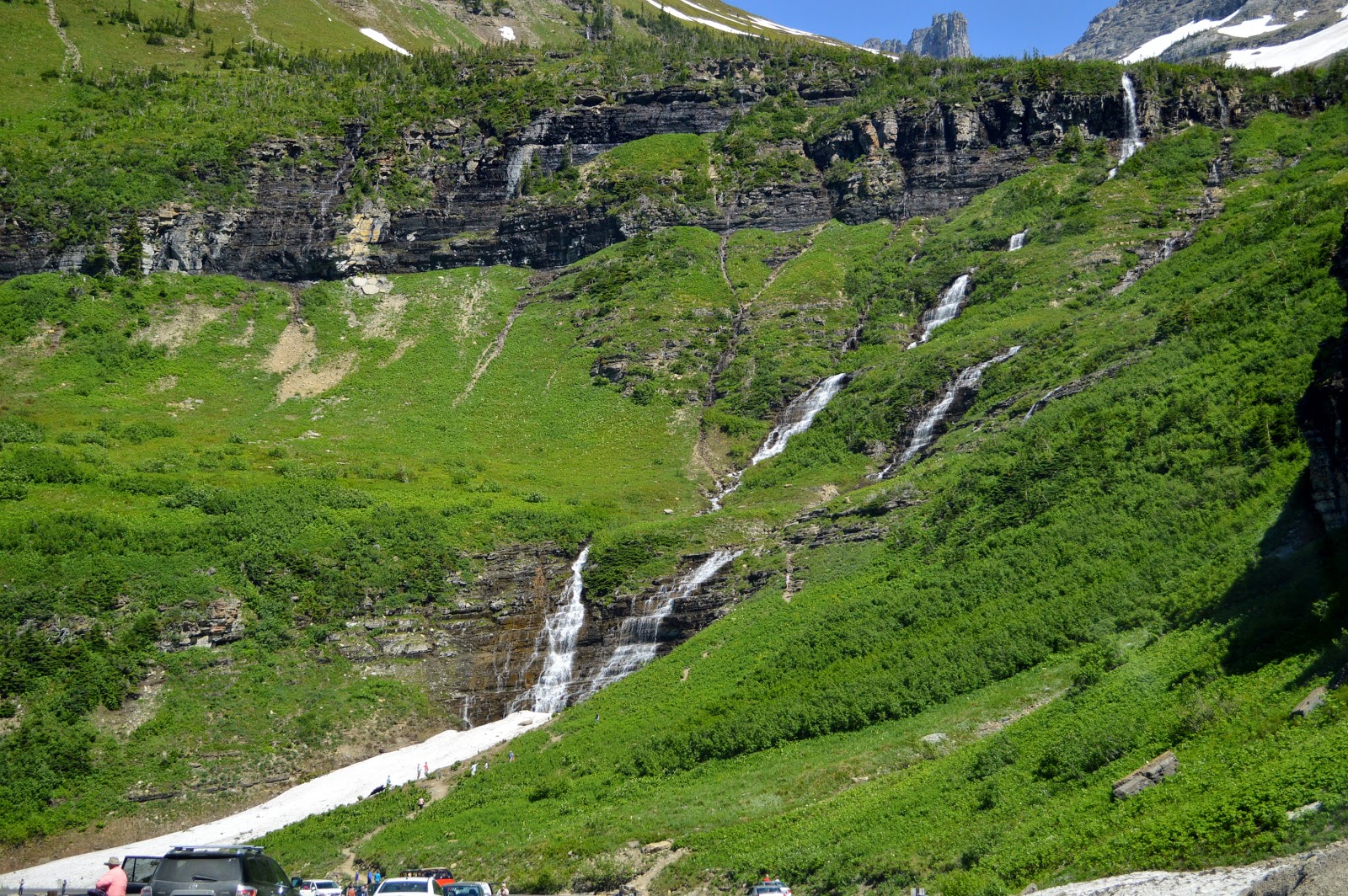 Over the course of our time in
Glacier, we would pull off many times for spectacular views and sometimes even
enjoy a picnic lunch on the side of the road.
From one pullout we were amazed that from that one location we could
easily see 10 different waterfalls in all directions, but unfortunately I had
no way to get a photo of that. You’ll
just have to trust that it was magnificent.
Yellowstone is amazing with its
great diversity and the abundance of wildlife, but the beauty of Glacier just cannot
be beat.
Over the course of our time in
Glacier, we would pull off many times for spectacular views and sometimes even
enjoy a picnic lunch on the side of the road.
From one pullout we were amazed that from that one location we could
easily see 10 different waterfalls in all directions, but unfortunately I had
no way to get a photo of that. You’ll
just have to trust that it was magnificent.
Yellowstone is amazing with its
great diversity and the abundance of wildlife, but the beauty of Glacier just cannot
be beat.

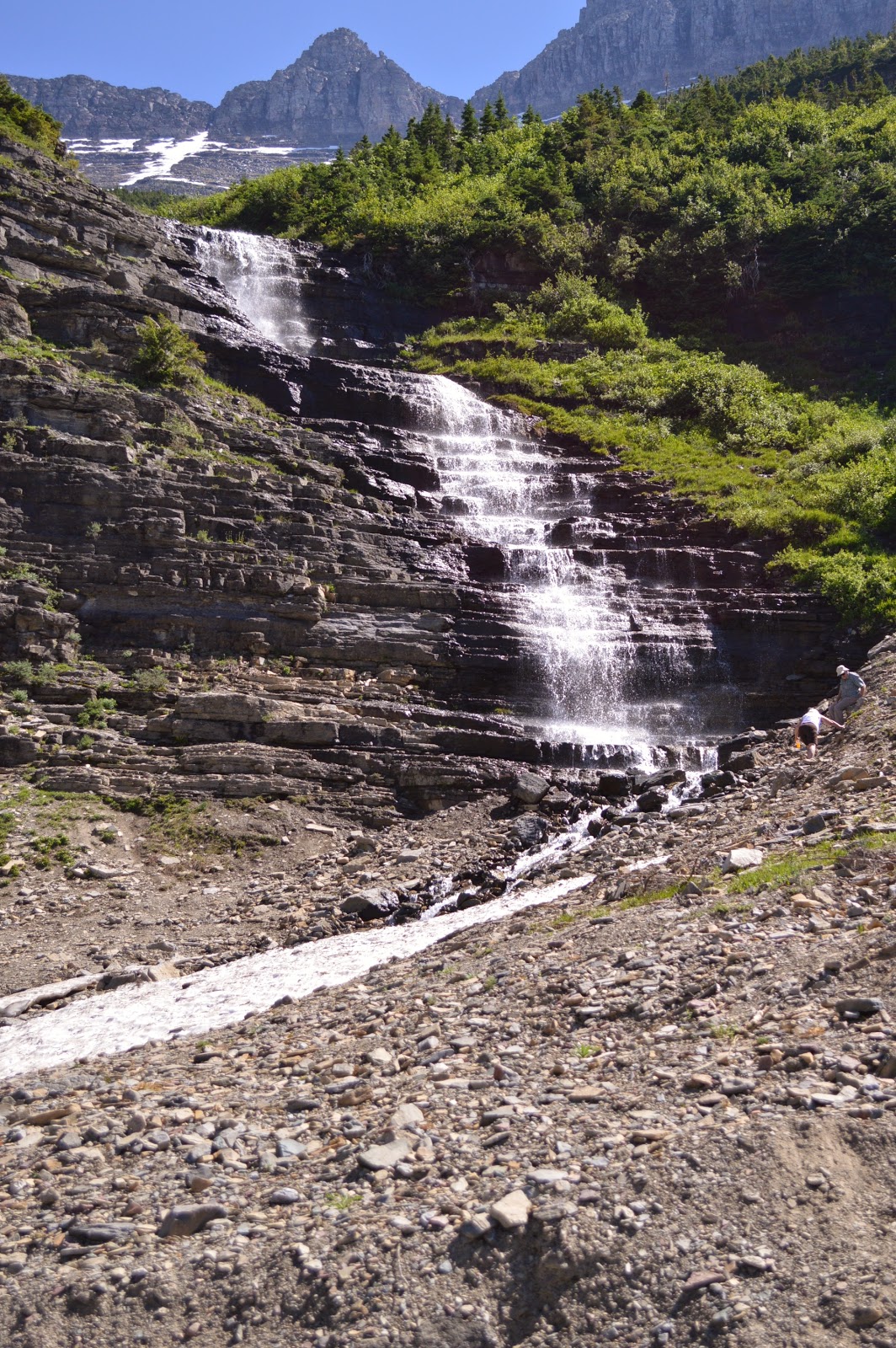

 On our way home we passed what we
initially thought was a herd of horses grazing on the hillside, but as it turns
out it’s actually 39 steel horses
that were created by sculptor Jim Dolan.
While
researching what exactly they were, I discovered that they are painted blue
with slashes of black
On our way home we passed what we
initially thought was a herd of horses grazing on the hillside, but as it turns
out it’s actually 39 steel horses
that were created by sculptor Jim Dolan.
While
researching what exactly they were, I discovered that they are painted blue
with slashes of black
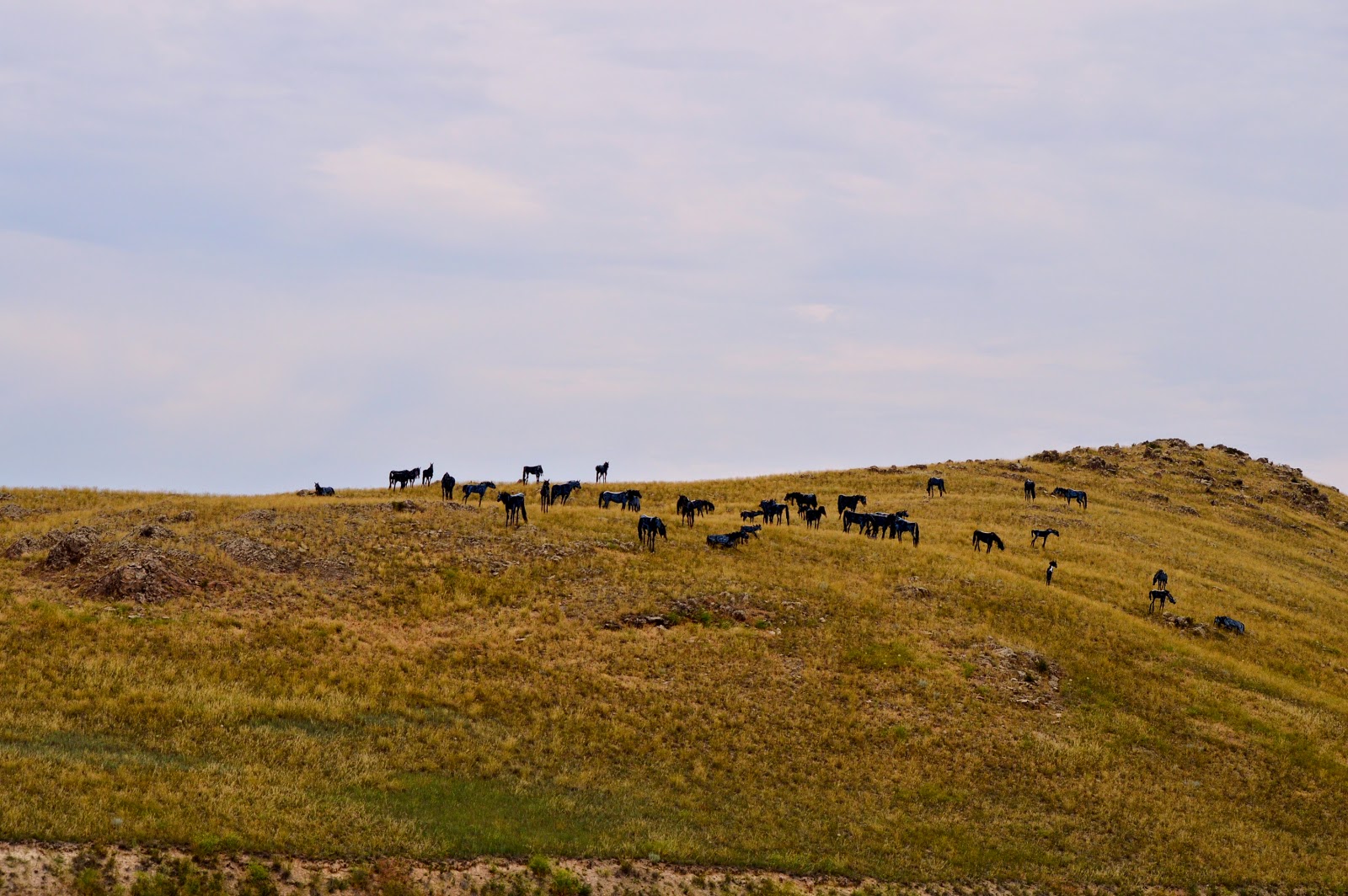 or white paint that create shadows and a three-dimensional
effect, the manes and tails are made of nylon rope, and some heads rest on ball
bearings so they move with the breeze. We
can vouch that from the highway they definitely do look very real!
or white paint that create shadows and a three-dimensional
effect, the manes and tails are made of nylon rope, and some heads rest on ball
bearings so they move with the breeze. We
can vouch that from the highway they definitely do look very real!

2 comments:
You two are certainly adventurous; and looking like you enjoy every minute of it. The waterfall scenes were great, as well as the rest. And the herd of horses looked real to me, and I wasn’t even there LOL.
Glad you are enjoying life. Sharon Kay
Your blog is simply fantastic, and your photos are wonderful! Nell
Post a Comment